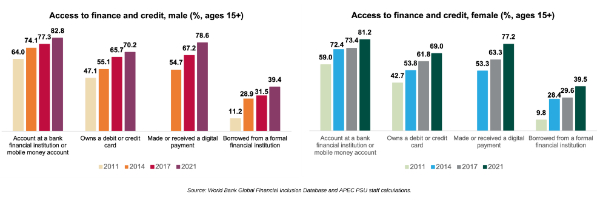Narrowing The Gender Gap In Access To Digital Finance Can Help Women To Thrive
By Rhea Crisologo Hernando
Digital inclusion and wider
access to financial services empower
women.
Financial
inclusion in the APEC region started out as an immediate
policy response to the 2008 Global Financial Crisis and
evolved into an important component of the region’s
inclusive growth strategy, particularly as a key
enabler of economic participation by opening up
opportunities for people to earn a living and
invest.
The COVID-19 pandemic, marked by
movement restrictions to curb the spread of the virus,
accelerated the shift to digitalization and increased the
global uptake of digital financial
services.
In APEC, data from the
2021 World Bank Global Financial Inclusion Index show that
the pandemic expanded access to and use of digital financial
services, particularly among women. Around 77 percent of the
region’s female population aged 15 years old and above
made or received a digital payment in 2021. This represented
a surge of 14 percent from 2017— a higher rate compared to
the increase in usage by men at about 11 percent within a
five-year period.

Increased
engagement in digital transactions reflect women’s wider
access to financial services as well as digital inclusion.
Moreover, making and/or receiving digital payments can pave
the way towards ownership accounts at formal financial
institutions or usage of mobile money services. Indeed, the
percentage of the population in APEC who reported having an
account at a bank or another type of financial institution,
or a mobile money account, has grown substantially since
2011. Similarly, more women and men owned a debit or credit
card in 2021, the most recent data available, relative to
other years.
The proportion of women conducting
everyday transactions online has also increased
significantly amid the pandemic. For example, the percentage
of women in the region using a mobile phone or the internet
to pay bills went up to 48 percent in 2021 from 32.5 percent
in 2017, equivalent to an increase of 15.5 percentage
points. In addition, there were more women (about 65
percent) using a mobile phone or the internet to buy
something online in 2021 when compared to both the 2017
level and the percentage of men conducting the same
transactions.
In terms of borrowing from
a formal financial institution, it is interesting to observe
that: one, slightly more women than men borrowed in 2021 and
two, the percentage of women borrowers jumped by 10 percent
amid the pandemic from the level in 2017—more than the
magnitude of the increase for men during the same comparable
period. These developments reflect how financial services
are becoming more inclusive nowadays, which are helping
advance women’s economic
opportunities.
Greater inclusiveness in
financial services has been critical to narrow considerably
the gender gap in access to financial accounts and services
within the APEC region. For example, the gender
gap in account ownership at a bank or its equivalent has
fallen to 1.6 percentage points in 2021 from as much as 5
percentage points a decade ago. Debit or credit card
ownership follows the same trend. Women are also starting to
close the gap relative to men in terms of access to and use
of digital financial services—from 3.9 percent in 2017 to
1.3 percent in 2021. There is also a noticeable narrowing of
the gender gap in the use of a mobile phone or the internet
to pay bills while the percentage of women buying something
online has outpaced men in both years.

The
ease of access and usage of digital financial services
encourages the shift to formalization of account ownership
and conduct of daily transactions online, providing a
crucial pathway towards improved financial and digital
inclusion. The emerging trend shows that more women in the
APEC region have benefitted from digital financial services
and opened formal accounts amid the pandemic, contributing
to a significant narrowing of gender gap in these areas.
Access to a bank or mobile money account is essential for
women to be able to engage in available economic
opportunities such as entrepreneurship, contribute to
household income and have an equal voice in family
decisions, and remain out of
poverty.
Closing the gender gap in
financial services is an important step forward towards
women’s empowerment. However, this needs to be
complemented by reducing gaps in women’s access to
education and skills development, participation in labor
markets, and representation in leadership roles, both in the
public and private sector, among others. Closing the gender
inequality in access and opportunities empowers women to
participate equally and fully in economic, financial and
social undertakings.
#
Rhea Crisologo
Hernando is a senior researcher at the APEC Policy Support
Unit.


 Greenpeace: The Deep Sea Mining Industry Is Crumbling And Desperate
Greenpeace: The Deep Sea Mining Industry Is Crumbling And Desperate UN News: Europe Grapples With Highest Number Of Measles Cases In More Than 25 Years
UN News: Europe Grapples With Highest Number Of Measles Cases In More Than 25 Years Polar Research and Policy Initiative: Comments On The Joint Statement By Greenland's Party Leaders In Response To Trump's Rhetoric On The Annexation Of Greenland
Polar Research and Policy Initiative: Comments On The Joint Statement By Greenland's Party Leaders In Response To Trump's Rhetoric On The Annexation Of Greenland Médecins Sans Frontières: MSF Briefs UN Security Council On Sudan - A Catastrophic 'War On People'
Médecins Sans Frontières: MSF Briefs UN Security Council On Sudan - A Catastrophic 'War On People' New Zealand Defence Force: New Zealand-Led Task Force Makes $NZ375-million Drug Bust In The Middle East
New Zealand Defence Force: New Zealand-Led Task Force Makes $NZ375-million Drug Bust In The Middle East ICHRP: ICHRP Welcomes Duterte’s Arrest - A Landmark Step Towards Justice
ICHRP: ICHRP Welcomes Duterte’s Arrest - A Landmark Step Towards Justice